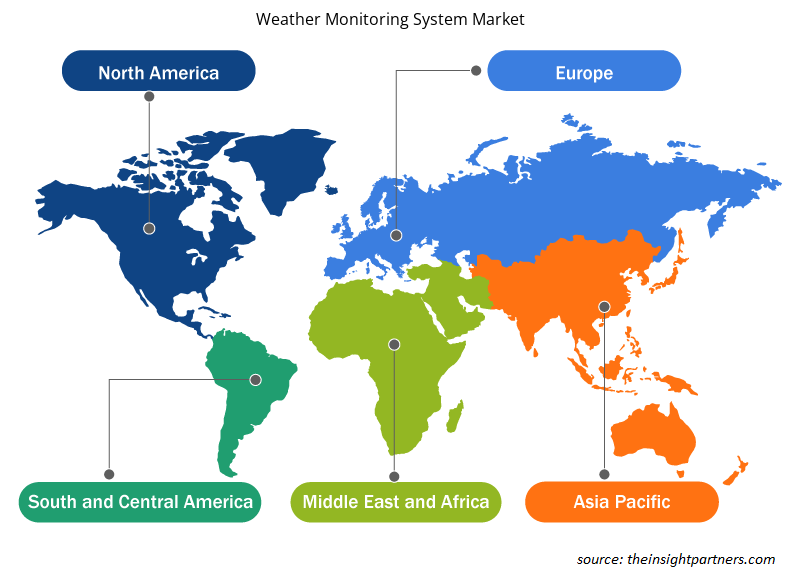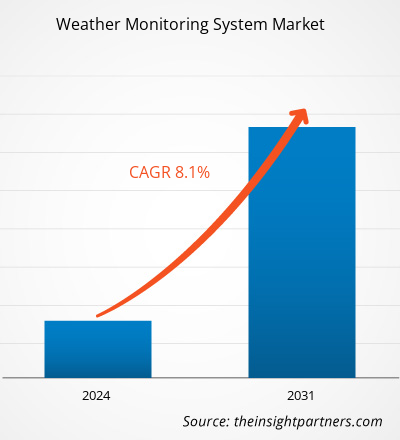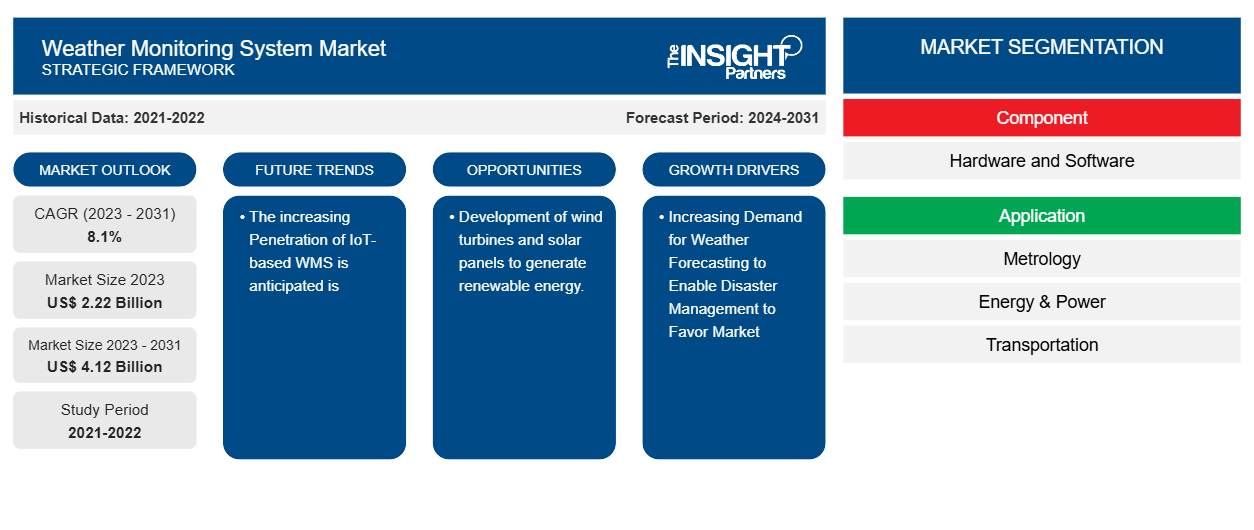من المتوقع أن يصل حجم سوق نظام مراقبة الطقس (WMS) إلى 4.12 مليار دولار أمريكي بحلول عام 2031 من 2.22 مليار دولار أمريكي في عام 2023. ومن المتوقع أن يسجل السوق معدل نمو سنوي مركب بنسبة 8.1٪ خلال الفترة 2023-2031. من المرجح أن يكون الاستخدام المتزايد للتنبؤ بالطقس لتمكين إدارة الكوارث والطلب المتزايد على التنبؤ بالطقس في صناعة الطيران من الاتجاهات الرئيسية والدوافع في سوق نظام مراقبة الطقس.
تحليل سوق أنظمة مراقبة الطقس
يشهد سوق أنظمة مراقبة الطقس نموًا كبيرًا على مستوى العالم. ويعزى هذا النمو إلى نمط تغير المناخ الذي يؤدي إلى عدم اليقين في الطقس والاستخدام المتزايد للتنبؤ بالطقس لتمكين إدارة الكوارث. علاوة على ذلك، ارتفاع إنتاج الطاقة المتجددة، وزيادة قدرات الحوسبة لأجهزة الكمبيوتر العملاقة للتنبؤ بالطقس وزيادة انتشار أنظمة إدارة المستودعات القائمة على إنترنت الأشياء.
نظرة عامة على سوق أنظمة مراقبة الطقس
المراقبة المستمرة أو الدورية أو التحليل لحالة المناخ والغلاف الجوي، بما في ذلك المتغيرات مثل درجة الحرارة والرطوبة وسرعة الرياح والضغط الجوي. علاوة على ذلك، تعد أجهزة استشعار درجة الحرارة والرطوبة أجهزة استشعار الطقس الأكثر استخدامًا. يمكن استخدامها لحساب مؤشر الحرارة، وفهم ما إذا كانت النباتات معرضة لخطر التلف بسبب الإفراط في ذلك أو معرفة ما إذا كان من الآمن العمل في منطقة معينة.
قم بتخصيص هذا التقرير ليناسب متطلباتك
ستحصل على تخصيص لأي تقرير - مجانًا - بما في ذلك أجزاء من هذا التقرير، أو تحليل على مستوى الدولة، وحزمة بيانات Excel، بالإضافة إلى الاستفادة من العروض والخصومات الرائعة للشركات الناشئة والجامعات
-
احصل على أهم اتجاهات السوق الرئيسية لهذا التقرير.ستتضمن هذه العينة المجانية تحليلاً للبيانات، بدءًا من اتجاهات السوق وحتى التقديرات والتوقعات.
محركات وفرص سوق أنظمة مراقبة الطقس
تزايد الطلب على التنبؤ بالطقس لتمكين إدارة الكوارث لصالح السوق
إن الطلب المتزايد على التنبؤ بالطقس لتمكين إدارة الكوارث هو في الواقع محرك لسوق أنظمة مراقبة الطقس. تعمل أجهزة/محطات مراقبة الطقس كأدوات أساسية في الاستعداد للكوارث والاستجابة لها. من خلال توفير بيانات الطقس الدقيقة وفي الوقت المناسب، تعمل هذه الأجهزة على تمكين الأفراد والمجتمعات والسلطات من التخطيط والتخفيف من المخاطر والاستجابة بكفاءة للكوارث. تعمل محطات الطقس كجسر بين الملاحظات الجوية وإدارة الكوارث، مما يعزز المجتمعات الأكثر أمانًا ومرونة. مع استمرار تقدم التكنولوجيا، فإن تبني الأساليب المبتكرة ودمج القدرات الجديدة سيعزز دور محطات الطقس في مستقبل إدارة الكوارث. وبالتالي، بالنظر إلى المعايير المذكورة أعلاه، فإن الاستخدام المتزايد للتنبؤ بالطقس لتمكين إدارة الكوارث يعمل كأحد محركات نمو سوق أنظمة مراقبة الطقس.
تطوير توربينات الرياح والألواح الشمسية لتوليد الطاقة المتجددة.
يعد نظام مراقبة الطقس أحد المكونات الرئيسية في محطة الطاقة الشمسية. وتتمثل وظيفته في جمع البيانات حول معلمات الطقس مثل درجة حرارة سطح الوحدة، والإشعاع الشمسي، ودرجة الحرارة المحيطة، وسرعة الرياح، وما إلى ذلك، في أي موقع للطاقة الشمسية الكهروضوئية، مما يساعد في مراقبة كفاءة وأداء محطة الطاقة. يساعد التحليل الإضافي لهذه البيانات فيما يتعلق بمخرجات المحطة في تحليل وتحسين أداء المحطة. علاوة على ذلك، لقياس بيانات الطقس لمحطة طاقة الرياح ، يتم تثبيت محطة الطقس القائمة على مسجل بيانات SmartSolo على برج الطقس الدائم لقياس سرعة الرياح واتجاهها على ارتفاعين، بالإضافة إلى درجة الحرارة والرطوبة النسبية وضغط الهواء. وبالتالي، نظرًا للمعلمات المذكورة أعلاه، من المتوقع أن يحمل تطوير توربينات الرياح والألواح الشمسية لتوليد الطاقة المتجددة العديد من الفرص لسوق نظام مراقبة الطقس في السنوات القادمة.
تقرير تحليل تجزئة سوق أنظمة مراقبة الطقس
إن القطاعات الرئيسية التي ساهمت في اشتقاق تحليل سوق نظام مراقبة الطقس هي المكون والتطبيق.
- بناءً على المكون، يتم تقسيم سوق أنظمة مراقبة الطقس إلى أجهزة وبرامج. ومن المتوقع أن يحظى قطاع الأجهزة بحصة سوقية كبيرة خلال فترة التوقعات.
- من حيث التطبيق، يتم تقسيم السوق إلى القياسات، والطاقة والكهرباء، والنقل، والطيران، وغيرها. ومن المتوقع أن يحظى قطاع القياسات بحصة سوقية كبيرة في الفترة المتوقعة.
تحليل حصة سوق أنظمة مراقبة الطقس حسب المنطقة الجغرافية
ينقسم النطاق الجغرافي لتقرير سوق نظام مراقبة الطقس بشكل أساسي إلى خمس مناطق: أمريكا الشمالية، ومنطقة آسيا والمحيط الهادئ، وأوروبا، والشرق الأوسط وأفريقيا، وأمريكا الجنوبية والوسطى.
سيطرت أمريكا الشمالية على سوق أنظمة مراقبة الطقس. يتم تقسيم سوق أمريكا الشمالية إلى الولايات المتحدة وكندا والمكسيك. أدت اتجاهات تبني التكنولوجيا العالية في مختلف الصناعات في منطقة أمريكا الشمالية إلى تغذية نمو سوق أنظمة مراقبة الطقس. تؤدي عوامل مثل زيادة اعتماد الأدوات الرقمية والإنفاق التكنولوجي المرتفع من قبل الوكالات الحكومية ونمط تغير المناخ في المنطقة إلى عدم اليقين في الطقس، ومن المتوقع أن يؤدي الاستخدام المتزايد للتنبؤ بالطقس لتمكين إدارة الكوارث إلى دفع نمو سوق أنظمة مراقبة الطقس في أمريكا الشمالية. علاوة على ذلك، فإن التركيز القوي على البحث والتطوير في الاقتصادات المتقدمة في الولايات المتحدة وكندا يجبر اللاعبين في أمريكا الشمالية على جلب حلول متقدمة تقنيًا إلى السوق. بالإضافة إلى ذلك، تمتلك الولايات المتحدة عددًا كبيرًا من اللاعبين في سوق أنظمة مراقبة الطقس الذين يركزون بشكل متزايد على تطوير حلول مبتكرة. تساهم كل هذه العوامل في نمو سوق أنظمة مراقبة الطقس في المنطقة.
رؤى إقليمية حول سوق أنظمة مراقبة الطقس
لقد قام المحللون في Insight Partners بشرح الاتجاهات والعوامل الإقليمية المؤثرة على سوق أنظمة مراقبة الطقس طوال فترة التنبؤ بشكل شامل. يناقش هذا القسم أيضًا قطاعات سوق أنظمة مراقبة الطقس والجغرافيا في جميع أنحاء أمريكا الشمالية وأوروبا ومنطقة آسيا والمحيط الهادئ والشرق الأوسط وأفريقيا وأمريكا الجنوبية والوسطى.

- احصل على البيانات الإقليمية المحددة لسوق نظام مراقبة الطقس
نطاق تقرير سوق نظام مراقبة الطقس
| سمة التقرير | تفاصيل |
|---|---|
| حجم السوق في عام 2023 | 2.22 مليار دولار أمريكي |
| حجم السوق بحلول عام 2031 | 4.12 مليار دولار أمريكي |
| معدل النمو السنوي المركب العالمي (2023 - 2031) | 8.1% |
| البيانات التاريخية | 2021-2022 |
| فترة التنبؤ | 2024-2031 |
| القطاعات المغطاة |
حسب المكون
|
| المناطق والدول المغطاة |
أمريكا الشمالية
|
| قادة السوق وملفات تعريف الشركات الرئيسية |
|
كثافة اللاعبين في سوق أنظمة مراقبة الطقس: فهم تأثيرها على ديناميكيات الأعمال
يشهد سوق أنظمة مراقبة الطقس نموًا سريعًا، مدفوعًا بالطلب المتزايد من المستخدم النهائي بسبب عوامل مثل تفضيلات المستهلك المتطورة والتقدم التكنولوجي والوعي المتزايد بفوائد المنتج. ومع ارتفاع الطلب، تعمل الشركات على توسيع عروضها والابتكار لتلبية احتياجات المستهلكين والاستفادة من الاتجاهات الناشئة، مما يؤدي إلى زيادة نمو السوق.
تشير كثافة اللاعبين في السوق إلى توزيع الشركات أو المؤسسات العاملة في سوق أو صناعة معينة. وهي تشير إلى عدد المنافسين (اللاعبين في السوق) الموجودين في مساحة سوق معينة نسبة إلى حجمها أو قيمتها السوقية الإجمالية.
الشركات الرئيسية العاملة في سوق نظام مراقبة الطقس هي:
- فايسالا
- لمسة الثالوث
- شركة ترافتيك سوليوشنز الخاصة المحدودة
- التلغراف كـ
- أنظمة كشف الصواعق من بولتيك
- شركة فري سبيريتس جرين لابز المحدودة
إخلاء المسؤولية : الشركات المذكورة أعلاه ليست مرتبة بأي ترتيب معين.

- احصل على نظرة عامة على أهم اللاعبين الرئيسيين في سوق أنظمة مراقبة الطقس
أخبار سوق أنظمة مراقبة الطقس والتطورات الأخيرة
يتم تقييم سوق أنظمة مراقبة الطقس من خلال جمع البيانات النوعية والكمية بعد البحث الأولي والثانوي، والذي يتضمن منشورات الشركات المهمة وبيانات الجمعيات وقواعد البيانات. فيما يلي بعض التطورات في سوق أنظمة مراقبة الطقس:
- في 11 أبريل، أطلق صاروخ فالكون 9 التابع لشركة سبيس إكس قمرًا صناعيًا لمراقبة الطقس تابعًا لقوات الفضاء الأمريكية. (المصدر: موقع شركة سبيس إكس، أبريل 2024)
- أطلقت منظمة أبحاث الفضاء الهندية بنجاح القمر الصناعي INSAT-3DS لمراقبة الطقس والتحذير من الكوارث. تم إطلاق القمر الصناعي على متن صاروخ GSLV-F14 من سريهاريكوتا. (المصدر: منظمة أبحاث الفضاء الهندية، بيان صحفي، فبراير 2024)
تقرير سوق أنظمة مراقبة الطقس والتغطية والنتائج المتوقعة
يقدم تقرير "حجم سوق نظام مراقبة الطقس والتوقعات (2021-2031)" تحليلاً مفصلاً للسوق يغطي المجالات التالية:
- حجم سوق نظام مراقبة الطقس وتوقعاته على المستويات العالمية والإقليمية والوطنية لجميع قطاعات السوق الرئيسية المشمولة بالنطاق.
- اتجاهات سوق نظام مراقبة الطقس بالإضافة إلى ديناميكيات السوق مثل المحركات والقيود والفرص الرئيسية.
- تحليل مفصل لقوى PEST/Porter الخمس و SWOT.
- تحليل سوق نظام مراقبة الطقس يغطي اتجاهات السوق الرئيسية والإطار العالمي والإقليمي واللاعبين الرئيسيين واللوائح والتطورات الأخيرة في السوق.
- تحليل المشهد الصناعي والمنافسة الذي يغطي تركيز السوق، وتحليل خريطة الحرارة، واللاعبين البارزين، والتطورات الأخيرة في سوق نظام مراقبة الطقس.
- ملفات تعريفية مفصلة للشركة.
- التحليل التاريخي (سنتان)، سنة الأساس، التوقعات (7 سنوات) مع معدل النمو السنوي المركب
- تحليل PEST و SWOT
- حجم السوق والقيمة / الحجم - عالمي، إقليمي، بلد
- الصناعة والمنافسة
- مجموعة بيانات إكسل
التقارير الحديثة
شهادات العملاء
سبب الشراء
- اتخاذ قرارات مدروسة
- فهم ديناميكيات السوق
- تحليل المنافسة
- رؤى العملاء
- توقعات السوق
- تخفيف المخاطر
- التخطيط الاستراتيجي
- مبررات الاستثمار
- تحديد الأسواق الناشئة
- تحسين استراتيجيات التسويق
- تعزيز الكفاءة التشغيلية
- مواكبة التوجهات التنظيمية























 احصل على عينة مجانية ل - سوق أنظمة مراقبة الطقس
احصل على عينة مجانية ل - سوق أنظمة مراقبة الطقس